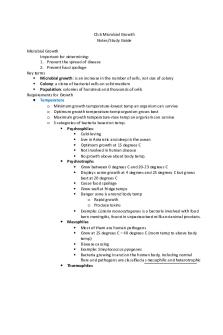Ch 6 - Lecture notes 6 PDF

| Title | Ch 6 - Lecture notes 6 |
|---|---|
| Course | Mod Org Chem II |
| Institution | University of Georgia |
| Pages | 3 |
| File Size | 280.7 KB |
| File Type | |
| Total Downloads | 2 |
| Total Views | 212 |
Summary
chapter 6 reactions...
Description
chem 2211 CH. 6 LINE RXNS ALKENE REACTIONS
SEMESTER PLANS AVAILABLE FOR: General Chemistry, Organic Chemistry, & Calculus 1
ON-CAMPUS PRIVATE TUTORING AVAILABLE FOR: General & Organic Chemistry, STAT 2000, MATH 1101, Pre-Calculus, Calculus 1, BIOL 1107, Biochem 3100, & Physics 1
WWW.NERDDAWGS.ORG | [email protected]
Acid addition in dichloromethane: a hydrogen halide (HCl, HBr, HI) is added to an alkene to form an alkyl halide. Stereochemistry preference: none Regiochemistry: Markovnikov
Acid-catalyzed addition of alcohol: an alcohol is added to an alkene to produce an ether. Stereochemistry preference: none Regiochemistry: Markovnikov
Halohydrin formation: a halogen (bromine/chlorine) is added to an alkene to form a cyclic intermediate and then water is added to form a halohydrin. Stereochemistry preference: Anti
Hydroboration-oxidation adds a hydrogen and water across the double bond to form an anti-Markovnikov alcohol with NO option for carbocation rearrangement. Stereochemistry preference: syn: the H and OH add on the same side. Regiochemistry: anti-Markovnikov
Epoxidation: an epoxide is formed from the reaction of an alkene and a peroxyacid. A peroxyacid is like a carboxylic acid with an extra oxygen, MCPBA is the most common peroxyacid used for this reaction. Stereochemistry preference: syn
Acid-catalyzed addition of water: water is added to an alkene to produce an alcohol. Stereochemistry preference: none Regiochemistry: Markovnikov
Addition of a halogen: a halogen (bromine/chlorine) is added to an alkene to form a 1,2-disubstitutted halo alkane. Stereochemistry preference: Anti: the 2 groups adding acros the double bone are opposite to each other.
Halohydrin formation: an alcohol can be added instead of water. The mechanism is identical to halohydrin formation. Stereochemistry preference: Anti
Oxymercuration-demercuration: forms a Markovnikov alcohol without possibility of rearrangement because the mechanism doesn’t proceed through a carbocation. Stereochemistry preference: none Regiochemistry: Markovnikov
Ozonolysis: cleaves alkenes into 2 carbonyl containing compounds. Reductive Ozonolysis leaves the double bond forming ketones, aldehydes, and formaldehydes.
Ozonolysis: cleaves alkenes into 2 carbonyl containing compounds. Reductive Ozonolysis leaves the double bond forming ketones, aldehydes, and formaldehydes.
Ozonolysis: cleaves alkenes into 2 carbonyl containing compounds. Reductive Ozonolysis leaves the double bond forming ketones, aldehydes, and formaldehydes.
Oxidative Ozonolysis: puts an oxygen where a hydrogen is Oxidative Ozonolysis: puts an oxygen where a hydrogen is t to form ketones, carboxylic acids, and carbon dioxide. (can form ketones, carboxylic acids, and carbon dioxide. (can use use 𝑂3 𝑜𝑟 𝐾𝑀𝑛𝑂4 reagents) 𝑂3 𝑜𝑟 𝐾𝑀𝑛𝑂4 reagents)
Oxidative Ozonolysis: puts an oxygen where a hydrogen is to form ketones, carboxylic acids, and carbon dioxide. (can Addition of hydrogen: 2 H atoms are added across an alken use 𝑂3 𝑜𝑟 𝐾𝑀𝑛𝑂4 reagents) to form an alkane. Stereochemistry preference: syn Regiochemistry: none...
Similar Free PDFs

Ch 6 - Lecture notes 6
- 3 Pages

Ch 6 - Lecture notes 6
- 4 Pages

CH - 6 Axial FLOW - Lecture notes 6
- 49 Pages

Ch 6 review - Lecture notes 6
- 4 Pages

Ch 6 lecture notes/outline
- 7 Pages

Ch 6/ Lecture 6 Answers
- 7 Pages

Chapter 6 - Lecture notes 6
- 5 Pages

Module 6 - Lecture notes 6
- 2 Pages

Chapter 6 - Lecture notes 6
- 6 Pages

Chapter 6 - Lecture notes 6
- 9 Pages
Popular Institutions
- Tinajero National High School - Annex
- Politeknik Caltex Riau
- Yokohama City University
- SGT University
- University of Al-Qadisiyah
- Divine Word College of Vigan
- Techniek College Rotterdam
- Universidade de Santiago
- Universiti Teknologi MARA Cawangan Johor Kampus Pasir Gudang
- Poltekkes Kemenkes Yogyakarta
- Baguio City National High School
- Colegio san marcos
- preparatoria uno
- Centro de Bachillerato Tecnológico Industrial y de Servicios No. 107
- Dalian Maritime University
- Quang Trung Secondary School
- Colegio Tecnológico en Informática
- Corporación Regional de Educación Superior
- Grupo CEDVA
- Dar Al Uloom University
- Centro de Estudios Preuniversitarios de la Universidad Nacional de Ingeniería
- 上智大学
- Aakash International School, Nuna Majara
- San Felipe Neri Catholic School
- Kang Chiao International School - New Taipei City
- Misamis Occidental National High School
- Institución Educativa Escuela Normal Juan Ladrilleros
- Kolehiyo ng Pantukan
- Batanes State College
- Instituto Continental
- Sekolah Menengah Kejuruan Kesehatan Kaltara (Tarakan)
- Colegio de La Inmaculada Concepcion - Cebu





